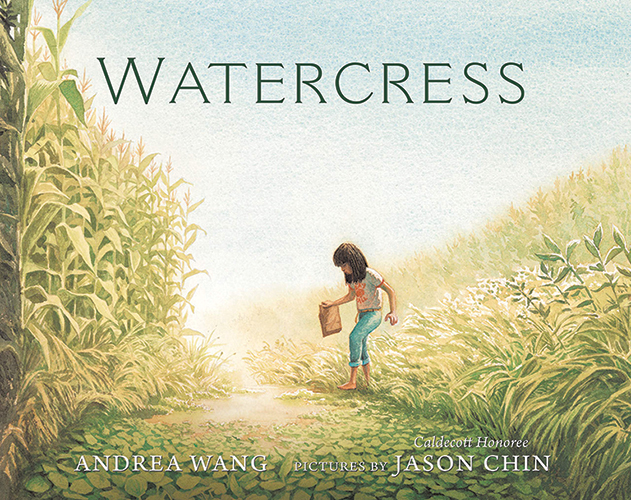
Watercress
Reviewed by Alison James
December 1, 2021
By Andrea Wang, illustrated by Jason Chin. Neal Porter Books, 2021. 32 pages. $18.99/hardcover; $11.99/eBook. Friends Journal recommends for ages 6–10.
When I was a child, my mother shared the secret of where to find the wild asparagus that grew in an irrigation ditch beyond the edge of town. For me, this was a treasure because asparagus was too expensive for us to get any other way. Besides, as my mother liked to declare, it was fresher and more delicious. For the child in Watercress, the experience of wild foraging comes with the shame that often stems from being different. A Chinese American child in predominantly White, rural Ohio, the last thing she wants is to be seen scrounging food from a muddy ditch. The two children in the story gather weeds with soggy, dripping roots covered with snails as a classmate drives past on the road. Wang leans into the discomfort, not protecting the reader from the shame and humiliation of scavenging for something to eat. At home with the watercress rinsed clean, sauteed in glistening garlic oil, and “freckled with sesame seeds,” the girl refuses to even taste it.
Here is where this brilliant book turns from being a simple, grotty memory into something profound. The mother goes to another room and brings back a family photo that shows her little brother “thin as a stem of watercress.” This was the girl’s uncle, the brother her mother never mentions. Quietly, the mother says, “During the great famine, we ate anything we could find . . .” The page turns. In the next image, there is no little brother, and the mother and father both seem to have aged 20 years in a day. “. . . but it was still not enough,” reads the text.
At that moment, the girl reveals a deep shame: “I am ashamed of being ashamed of my family.”
This epiphany goes far beyond where most picture books dare to go. It reaches beyond the othering experience of many immigrants to a universal feeling: being ashamed of your own family. Nearly everyone can understand this, and from that emotional resonance, readers of all ages can open the window of empathy: this child is not so different from me.
The watercress dish, when at last she takes a bite, “bites me back with its spicy, peppery taste. It is delicate and slightly bitter, like Mom’s memories of home.”
Jason Chin’s watercolor palette emphasizes yellow ocher, a color of the ’70s, and cerulean blue, a color that harkens back to China. He used Western and Chinese watercolor brushes to give the landscape both precision and a dreamlike quality. As exemplified by the overnight aging of the girl’s grandparents when they lost their son, Chin’s deft drawing deepens the emotional range of the sparse text, bringing home the poignancy and hope of this extraordinary story.
The publisher lists this book as being for ages four through eight, but I feel it would incite a lively and insightful discussion among older children who are able to react with empathy and compassionate understanding. It might be well paired with Linda Sue Park’s book Prairie Lotus.
Alison James is a member of South Starksboro (Vt.) Meeting.


